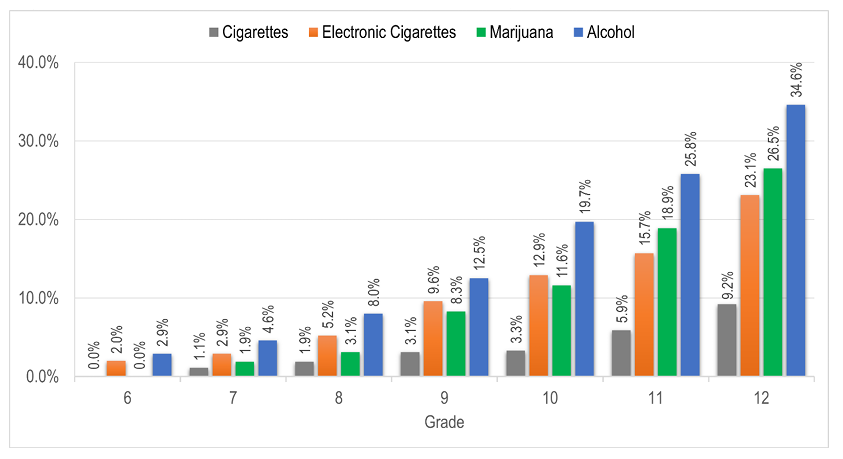April is National Alcohol Awareness Month
Posted on
As we transition into a new month and a new season, we also begin observing National Alcohol Awareness Month. Each year, April puts the focus on both the causes and the effects of alcohol use disorder, and on the most effective strategies for preventing substance use disorder before it begins.
In Connecticut as well as across the country, alcohol is the most commonly used of all substances, leading many to feel a false sense of security about its risks. But alcohol consumption can have catastrophic impacts on our health, our families, and the safety of our communities—and it’s time to talk about that.
Let’s Talk About Underage Drinking
While alcohol misuse is dangerous at any age, the risk for developing alcohol use disorder is highest among young people—50% greater, in fact, if one begins drinking before age 15.
Unfortunately, this is not uncommon. SERAC’s 2021-22 Youth Survey polled more than 7,000 students in grades 6-12 in New London and Windham counties, and found that at every grade level, more students reported having ever used alcohol than any other substance—more than cigarettes, e-cigarettes, and marijuana. 16.6% of all youth surveyed had drank alcohol at least once in their lives. Rates were lowest among the youngest respondents (just under 3% of sixth-graders had used alcohol), and climbed steadily across each of the higher grade levels, peaking at more than one-third (34.6%) of high school seniors.
Lifetime Use of Common Substances of Concern Among Youth in Grades 6-12:

The best way to combat addiction is to prevent it, and that means reaching these young people before they have their first drink or begin to drink regularly. Research shows that parents have a much bigger impact on this than they may realize, simply by providing a caring home environment, setting clear rules about drinking, and having open, honest conversations about substance misuse. These give your child the support they need to stay away from alcohol, and to turn it down when offered. If you’re not sure where to start, 21 Reasons Why the Drinking Age is 21 can give you valuable points to guide both your rules and your discussions.
It’s crucial for parents and community members to understand what makes underage drinking so risky—and they must also remember the legal risks to themselves if they allow it to happen. One of SERAC’s key accomplishments was advocating for Connecticut’s Social Host Law, under which residents can face fines or jail time for allowing minors to use alcohol or cannabis on their property. Under this law, it is everyone’s responsibility to prevent underage drinking.
Let’s Talk About Coping Strategies
The COVID-19 pandemic exacerbated our country’s already problematic relationship with alcohol, almost doubling rates of alcohol use disorder in people aged 12+. It’s clear that amidst the stress and anxiety of the pandemic—and while coping with grief, job losses, and an ever-deepening political divide—many Americans turned to alcohol.
This shocking increase in alcoholism speaks to a great need for strong public education programs to help people of all ages build resilience, learn healthy coping strategies, and recognize the earliest signs of addiction. With better tools for self-care, in conjunction with a better awareness of why alcohol is so dangerous for teens and adolescents, parents and adult community members can more effectively model positive behaviors for young people, and can set boundaries to prevent underage drinking.
Let’s Talk About Advocacy
During the pandemic, many states loosened their liquor laws: allowing home delivery of alcohol, lowering the minimum age for workers to serve alcohol, and permitting bars and restaurants to sell alcohol “to go.” Initially temporary measures to help keep the hospitality industry afloat during the hardships of the pandemic, many of these policies have since become permanent. (In Connecticut, to-go cocktails were signed into legislation in 2023.) Yet emerging research shows that these changes made it easier for underage youth to access alcohol, and likely contributed to the spike in heavy drinking seen nationwide.
More recently, Connecticut legislators were shocked by skyrocketing fatalities on the state’s roads, with 2022 the worst year on record since 1989. In fact, Connecticut consistently ranks among the top 3-5 in the nation when it comes to alcohol-related driving fatalities. They have proposed lowering the blood alcohol content (BAC) for arrest from .08 (the national standard) to .05, a threshold currently in place only in Utah, but common in many other countries. Legislators hope that this change may encourage residents to use rideshare apps, public transportation, or a designated driver rather than getting behind the wheel after drinking. Ultimately, keeping impaired drivers off the roads could reduce the number of crashes, save hundreds of lives, and make the state safer for everyone.
It’s clear that policymakers are trying to strike a balance with the state’s liquor laws, taking the available evidence, best practices, and public interests into consideration. We urge you to make your voice heard! Express your concern about alcohol-related issues, or your thoughts about the current proposals, by contacting your local legislators. Advocacy is an important way that Connecticut citizens can take action during Alcohol Awareness Month.
